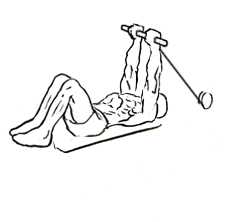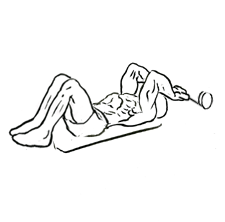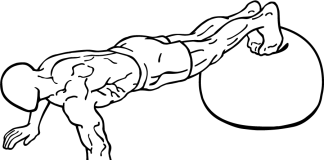Last Updated on September 24, 2014
When it comes to sculpting defined and strong triceps, the Low Triceps Extension with Cable is an excellent exercise to add to your routine. This movement isolates the triceps, engages the core for stabilization, and provides a unique angle that enhances muscle activation. In this guide, we’ll walk you through everything you need to know about performing the exercise correctly and safely, maximizing gains, and avoiding common pitfalls.
What is the Low Triceps Extension with Cable?
The Low Triceps Extension with Cable is an isolation exercise primarily targeting the triceps, specifically the long head of the triceps brachii. By lying on a seated row station and using a cable pulley with a rope attachment, this exercise provides constant tension throughout the movement, enhancing muscle engagement compared to traditional free weight triceps extensions.
Muscles Worked
- Primary Muscles: Triceps (long head, lateral head, and medial head)
- Secondary Muscles: Forearms (for gripping), core (for stabilization), and shoulders (anterior deltoids for holding arm position)
Benefits of the Low Triceps Extension with Cable
- Constant Tension: Unlike free weights, cables provide consistent tension throughout the entire range of motion, leading to better muscle engagement and growth.
- Improved Triceps Definition: By focusing specifically on the triceps, this exercise helps in developing muscle definition and strength.
- Safe on the Joints: The controlled movement and adjustable resistance make it safer for those with shoulder or elbow issues compared to other triceps exercises like skull crushers.
- Versatility and Adaptability: This exercise can be modified for different skill levels by adjusting the weight or the cable attachment.
- Functional Strength: Building triceps strength is crucial not just for aesthetics but also for improving performance in other compound exercises like bench presses, push-ups, and shoulder presses.
How to Perform the Low Triceps Extension with Cable
Equipment Needed:
- Seated row station with a cable pulley
- Rope attachment
Step-by-Step Instructions:
- Set Up:
- Attach a rope to the low pulley of a seated row station. Adjust the weight stack to a level that you can lift for 10-12 reps while maintaining good form.
- Lie on your back on the bench of the seated row station with your head facing the weight stack. Position your body so your head is near the cable attachment point.
- Positioning:
- Grasp the rope with both hands, palms facing each other (neutral grip).
- Raise your arms directly above your chest, ensuring your forearms are parallel to the floor. Your elbows should be bent at about a 90-degree angle.
- Execution:
- Extend Your Arms: Slowly extend your arms upward by straightening your elbows. Focus on squeezing your triceps as you push the rope forward and upward. Ensure that your upper arms remain stationary and that only your forearms move.
- Engage the Core: Keep your core tight to maintain stability and prevent your lower back from arching during the movement.
- Lowering the Weight:
- Slowly bring your hands back to the starting position, keeping the tension on your triceps throughout the movement. Aim for a controlled descent to avoid any jerking motions.
- Repeat:
- Complete 3-4 sets of 10-12 reps for maximum muscle growth. Ensure proper rest between sets (60-90 seconds) to allow your muscles to recover.
Tips for Perfecting Your Form
- Maintain a Neutral Grip: This grip position helps reduce strain on the wrists and elbows, making the exercise safer and more comfortable.
- Control the Movement: Avoid using momentum. Instead, move slowly and deliberately to maximize tension on the triceps and minimize the risk of injury.
- Keep Upper Arms Stationary: Your elbows should remain locked in position throughout the movement. Allowing them to move can reduce triceps activation and involve the shoulders too much.
- Don’t Overextend: Make sure not to lock out your elbows at the top of the movement. This keeps the tension on the triceps and prevents joint stress.
Common Mistakes to Avoid
Even seasoned lifters can make mistakes that reduce the effectiveness of the exercise or risk injury. Here are a few common ones:
- Using Too Much Weight:
- Lifting a weight that’s too heavy can lead to using improper form, swinging the arms, or engaging other muscles like the shoulders. Choose a weight that challenges you but allows you to maintain control throughout the set.
- Arching the Lower Back:
- Arching the back during the exercise takes tension off the triceps and can lead to injury. Engage your core to stabilize your body and keep your back flat against the bench.
- Letting the Elbows Flare Out:
- Your elbows should stay close to your body. Allowing them to flare out can cause shoulder strain and take the focus away from the triceps.
- Rushing Through the Movement:
- Speeding through the reps doesn’t provide the same muscle activation as slow, controlled movements. Focus on quality over quantity.
Variations of the Low Triceps Extension with Cable
To keep your workouts fresh and continue making gains, try these variations:
- Single-Arm Cable Triceps Extension:
- Perform the exercise using one arm at a time. This can help correct any muscle imbalances between your left and right triceps.
- Reverse Grip Low Triceps Extension:
- Rotate your palms to face up (supinated grip) while holding the rope. This shifts the emphasis slightly and targets different triceps fibers.
- Standing Low Triceps Extension:
- Instead of lying down, perform the exercise while standing with the cable pulley set to a low position. This engages your core even more and requires greater balance.
- Cross-Body Low Triceps Extension:
- Using a single handle attachment, pull the cable across your body, extending the triceps diagonally. This variation targets the triceps while also working the core for stabilization.
Safety Tips
To prevent injury and get the most out of this exercise, follow these safety tips:
- Warm Up Properly: Always warm up your triceps and shoulders before starting with dynamic stretches or light resistance band work.
- Start with Light Weights: If you’re new to this exercise, begin with a lighter weight to perfect your form before progressing to heavier loads.
- Use a Full Range of Motion: Ensure your arms fully extend during the exercise, but don’t lock out your elbows. This maximizes muscle activation while protecting your joints.
- Listen to Your Body: If you feel pain (not to be confused with muscle burn) in your shoulders or elbows, stop the exercise and assess your form or adjust the weight.
Integrating the Low Triceps Extension into Your Routine
To maximize your triceps growth, consider integrating the Low Triceps Extension with Cable into your arm day routine. Pair it with other exercises such as:
- Overhead Dumbbell Triceps Extension: This complements the low triceps extension by targeting the triceps from a different angle.
- Skull Crushers: Adding variety by using a barbell or dumbbells for a classic triceps workout.
- Triceps Pushdowns: Performing pushdowns with a cable and rope attachment targets the lateral head of the triceps.
Sample Workout Routine:
- Overhead Dumbbell Triceps Extension: 3 sets of 10 reps
- Low Triceps Extension with Cable: 3 sets of 12 reps
- Skull Crushers: 3 sets of 8-10 reps
- Triceps Pushdowns: 3 sets of 12-15 reps
Frequently Asked Questions
- Is the Low Triceps Extension with Cable suitable for beginners?
- Absolutely! This exercise is suitable for all fitness levels. Beginners should start with lighter weights and focus on mastering their form before increasing resistance.
- How often should I perform this exercise?
- For optimal growth, aim to train triceps 2-3 times per week, ensuring at least 48 hours of rest between sessions.
- Can I use other attachments besides the rope?
- Yes, you can experiment with straight bars or single handles for a different grip and feel. Each attachment slightly changes the angle and muscle engagement.
- Why should I choose cable exercises over free weights for triceps?
- Cables offer consistent tension and a controlled range of motion, reducing the risk of injury and providing a different form of resistance compared to dumbbells or barbells.
The Low Triceps Extension with Cable is a powerful addition to any arm workout routine. With its ability to isolate the triceps and provide constant tension, it’s perfect for those looking to build strength and definition. By following the correct form, avoiding common mistakes, and incorporating variations, you’ll be well on your way to achieving your fitness goals. Remember, consistency and proper technique are key!








